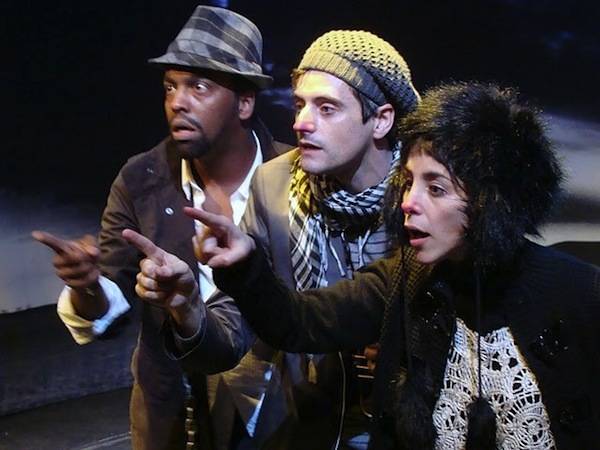Reinventing La Strada: an Italian Classic in Spanish Speaking New York
Many Italian film fans recall La Strada with a sense of playful melancholy. The story represents the search for one’s path, or ‘road’, in life. The portrayal of the lives of Italy’s traveling performers crosses boundaries, and makes its way to New York with the Spanish language theater group, La Strada Company.
La Strada Company is a theater group based in New York City that utilizes the power of the Spanish language to bring together diverse people with incredible talent. The company produced a stage adaptation of Federico Fellini’s 1954 classic film La Strada, which debuted on February 23, 2011 at IATI Theatre Todo Vanguardia in the heart of the East 4th street cultural district, where a number of small theaters operate.
Acclaimed director René Buch (Artistic Director of Spanish Repertory in New York), with the collaboration of Jorge Merced (Artistic Director of Pregones Theatre), directed this production of “La Strada”. Using a Catalan interpretation of the original story, the directors made artistic decisions about elements from the film that would be emphasized and/or omitted in order to reinvent the story of traveling artists and their journeys, challenges, triumphs and the devastating experience of living ‘on the road’ while trying to use their talents to survive.
The ‘compania artistica’ performed its version of La Strada with its own vision of comedic life. The character around which the whirlwind of action occurs is not Gelsomina, but the Fool (El Loco), who appears at the beginning of the play as trying to understand and capture a beam of light. He is joined by two clown comrades, Abrigo and Sombrero, and all three of them decide that mundane objects, such as a trumpet, a stone, or a linked chain, can tell stories. Thus the story of Gelsomina and Zampano` ensues from this idea.
The original film starred Anthony Quinn as the brutish Zampano`, Richard Baseheart as the Fool, and Fellini’s own wife, Giulietta Masina, as Gelsomina, a girl who is purchased from an impoverished family to be the feigned wife/assistant of Zampano`. In the company’s modern interpretation, the plot remains the same; we see the way Zampano` does not think, and the way Gelsomina longs for love and acceptance in her new life as a traveling artist. We also see how El Loco helps Gelsomina understand that she is good for something, that we all have a purpose, but that Zampano`’s nature does not allow him to think or give love to others. He only knows struggle and survival, and feelings do not matter much in his world. As in the film, Zampano` and the fool fight on stage and represent opposing forces. Although Gelsomina is attracted to both men, she finds herself fulfilling her loyalty to Zampano`, who hits and belittles her, because El Loco reminds her that if she does not stay with Zampano`, who will?
The play focuses on the same themes present in Fellini’s film: the life of poor artists and circus misfits, living precariously and at times like vagabonds, roaming through towns without much except their talents and the hope of bringing laughter to ‘plazas’ (piazza/town squares). During the performance, two women play music offstage — violin and trumpet — which adds a sense of joy to the show, and indicates an homage to the original film which makes great use of music, as is always the case in Fellini’s films. The slapstick comedic elements contrast with the cathartic ending of the play, when Zampano` realizes he has caused the death of Gelsomina and is left alone. We also learn in the play that the father of Zampano` was a performer, a man of strength whose greatness his son could never equal. Zampano`, like the other characters, must find his own path and cannot be constrained by the past.
The members of La Strada Company include Irene Aguilar (Spain) as Gelsomina, Luis Carlos de La Lombana (Spain) as Zampano`, Israel Ruiz (Spain) as the Fool, or El Loco, Nanda Abella (Argentina) as Abrigo, and Winston Estévez (IATI company member from the Domincan Republic) as Sombrero, both clowns; and Adela Maria Bolet (Cuba) as the woman who tells Zampano` at the end that Gelsomina has died. Eduardo Aguilar and Nacho Blanco are both executive producers of the show.
The array of accents and words in Spanish dialects evoked laughter among the audience and created a pleasant sense of diversity, mirroring the variety of Spanish heard today in New York. El Loco was particularly hilarious and at times sagacious, while the brute force of Zampano` translated very well in La Lombana’s role. Irene Aguilar also captured the fragile simplicity of Gelsomina, and was wonderful, but of course it is difficult for anyone to come close to Giulietta Masina.
After a magnificent string of performances in New York, La Strada Company plans to take a subsequent tour of this production to Washington D.C. and Miami in 2011. The group also intends to take the show to Spain and Italy this summer. It will be interesting to see the Italian audience’s reception of the production.
The play was co-produced by IATI (International Theater Arts Institute) and Todo Vanguardia, and was sponsored by the Consulate General of Spain in New York, and the Italian Cultural Institute. Luis Carlos de la Lombana, the director of La Strada Company, in describing this production on the playbill, says profoundly that, “there is a path drawn for each one of us based on our will and our needs…remember that once you are on it, there is no going back”, summing up the message of the story of La Strada that lives on and reinvents itself today.
La Strada the film is still celebrated and screened worldwide, and its interpretation into a play in Spanish signifies its lasting impact on this generation of performers, artists and spectators alike.









































i-Italy
Facebook
Google+
This work may not be reproduced, in whole or in part, without prior written permission.
Questo lavoro non può essere riprodotto, in tutto o in parte, senza permesso scritto.